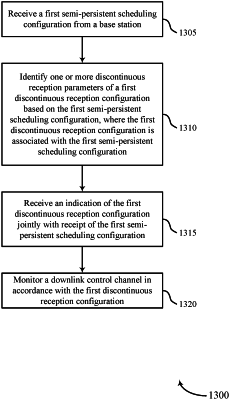| CPC H04W 76/28 (2018.02) [H04W 24/08 (2013.01); H04W 72/1263 (2013.01); H04W 80/02 (2013.01)] | 30 Claims |

|
1. A method for wireless communications at a user equipment (UE), comprising:
receiving, from a network device, an indication of a mapping between a plurality of semi-persistent scheduling configurations and a plurality of respective discontinuous reception configurations;
receiving an indication of a first semi-persistent scheduling configuration from the network device, wherein the plurality of semi-persistent scheduling configurations includes the first semi-persistent scheduling configuration;
identifying one or more discontinuous reception parameters of a first discontinuous reception configuration based at least in part on the indication of the first semi-persistent scheduling configuration and based at least in part on the mapping, wherein the first discontinuous reception configuration is associated with the first semi-persistent scheduling configuration; and
monitoring a downlink control channel in accordance with the first discontinuous reception configuration.
|